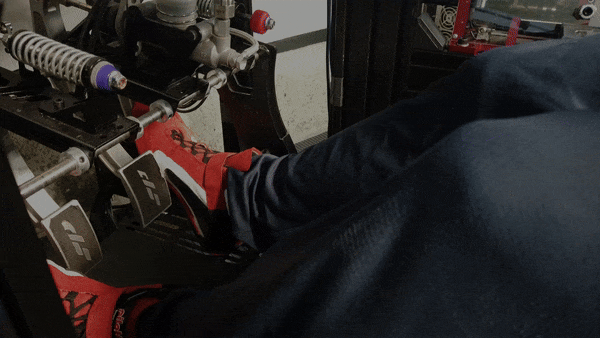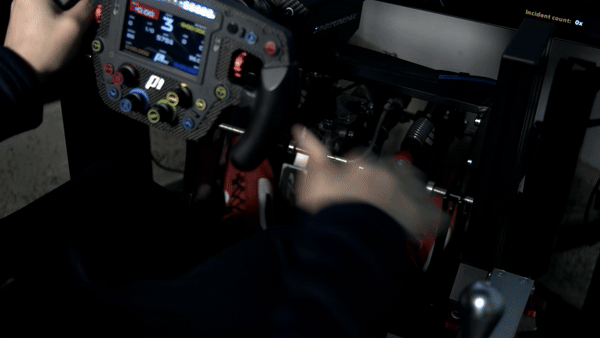There’s a lot to consider when it comes to selecting the right set of pedals for your sim rig. This article will explore the different options and what differentiates them based on the price, feel, design, technology & build quality. Check out the Right Stuff Racing Parts Picker to see all the pedal options as you research your choice.

Types of Sim Racing Pedal Technology
Sim racing pedals utilize various technologies to detect and transmit input signals to the racing simulation software. Here’s an explanation of the different pedal technologies commonly found in sim racing:
Potentiometer-based Pedals:
- How it works: Potentiometers are variable resistors that measure the position of the pedal by detecting changes in resistance as the pedal is depressed. As the pedal moves, the resistance changes, which is translated into a corresponding input signal.
- Pros:
- Cost-effective: Potentiometer-based pedals are often more affordable compared to other technologies.
- Simple design: Potentiometers are straightforward to implement, making them suitable for entry-level sim racing setups.
- Cons:
- Limited accuracy: Potentiometers may suffer from inaccuracies and wear over time, leading to reduced precision and consistency.
- Susceptible to wear: Continuous use can lead to degradation of the potentiometer’s components, affecting performance and reliability.
Load Cell-based Pedals:
- How it works: Load cells measure force applied to the pedal by converting mechanical force into electrical signals. When pressure is exerted on the pedal, the load cell deforms slightly, producing a proportional electrical signal that represents the input.
- Pros:
- Enhanced accuracy: Load cells offer precise and consistent input detection, resulting in improved throttle and brake control.
- Realistic feel: Load cell pedals provide a more authentic driving experience by simulating the pressure-sensitive nature of real-world pedals.
- Cons:
- Higher cost: Load cell pedals tend to be more expensive compared to potentiometer-based alternatives due to the advanced sensor technology.
- Calibration may be required: Load cell pedals may require periodic calibration to maintain optimal performance and accuracy.
Hydraulic-based Pedals:
- How it works: Hydraulic pedals use fluid pressure to detect pedal inputs, similar to the hydraulic systems found in real racing cars. When the pedal is pressed, hydraulic pressure changes, which is translated into electrical signals for input.
- Pros:
- Realistic feel: Hydraulic pedals closely mimic the feel of real racing pedals, providing immersive feedback and control.
- Precise modulation: Hydraulic systems offer fine control over throttle and brake inputs, allowing for subtle adjustments during driving.
- Cons:
- Complexity: Hydraulic pedal systems are more complex to design and manufacture, resulting in higher costs and potential maintenance requirements.
- Limited availability: Hydraulic pedals are less common in the consumer market compared to potentiometer and load cell-based alternatives.
Each pedal technology has its advantages and drawbacks, and the choice ultimately depends on factors such as budget, desired realism, and performance requirements. Many sim racers prefer load cell pedals for their superior accuracy and realism, while others may opt for potentiometer-based pedals for their affordability and simplicity. Hydraulic pedals are less common but offer unparalleled realism for enthusiasts seeking the most authentic driving experience.

Exploring Top Pedal Choices
- Fanatec CSL V2: A durable starter to intermediate option.
- Sim-Lab XP-1 Load Cell Pedals: Highly adjustable and smooth-feeling pedals ideal for beginner to advanced intermediate drivers.
- Heusinkveld Sprint Sim Pedals: Strong, compact, and highly adjustable pedals suitable for serious hobbyists and provide a great bang for your buck.
- VRS Pedals – Built with premium materials and replicate the tactile feedback and responsiveness of real racing pedals, providing sim racers with an immersive and authentic driving experience.
- Heusinkveld Ultimate+ Pedals: Professional-grade pedals capable of simulating pedal forces experienced in top-tier racing cars.
- Simtrecs ProPedal GT: CNC-machined pedals with customizable features and impressive pedal feel.
- Simagic P2000 Pedals: High-quality CNC-machined pedals with customizable options, suitable for various pedal forces.
- Meca EVO 1 Pedal Set: Hydraulic pedals focusing on reliability, robustness, and adjustability.
- Cube Controls SP01 Pedals: Precision pedals with CNC-machined aluminum body and carbon fiber throttle plate for superior performance and durability.
- Simagic P1000 Modular Pedal Set: Innovative pedal set offering powerful race-inspired performance and impeccable engineering.
- Venym Atrax Black Formula-Style Pedals: Premium pedals with full load cells designed for authentic driving sensations.
- Asetek SimSports™ Pedal Sets: Hydraulic pedal sets offering realistic pedal feel and high-quality construction.
- Simucube ActivePedal: Groundbreaking pedal technology offering unlimited adjustability, force feedback effects, and personalized driving experience.
Unlocking Greater Performance with Pedal Upgrades
Pedals serve as the crucial link between you and your car’s behavior on the track. Improved pedal control enhances aspects like trail braking and throttle management, pivotal for achieving faster lap times. With each pedal upgrade, I’ve noticed significant improvements in brake control and throttle precision. High-end sim racing pedals boast robust components capable of handling realistic brake forces, alongside sophisticated electronics like load cells for precise input measurement.
Why Prioritize Pedals in Your Upgrades
I always advocate for upgrading pedals first when enhancing your rig. Pedal upgrades offer one of the most substantial improvements in your racing experience. Better control and manipulation of the car are primarily achieved through pedals, allowing you to exploit every possible advantage in the competitive racing environment.
Adjustability for Personalized Experience
Adjustability is key in a sim pedal set, especially for those employing techniques like heel-and-toe. Higher-end pedals offer extensive adjustability, allowing users to fine-tune pedal spacing, angle, and position to mimic real-world race car setups.
Resale Value
Investing in quality pedals ensures minimal depreciation and easy resale if well-maintained. Upgrading pedals can significantly enhance your driving experience, making every race more enjoyable and rewarding.
Whether you’re a beginner or a seasoned racer, upgrading your pedals is a crucial step in improving your performance and overall enjoyment of sim racing. Choose wisely and enjoy the process of refining your driving skills.
